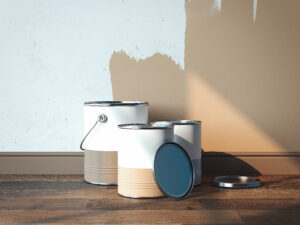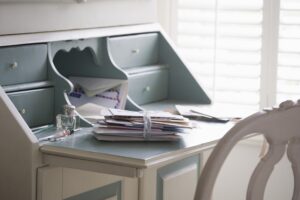What is the best part of the painting process? The prep work, right? The cleaning, the rigorous sanding, treating the brushes—it just can’t be beat, right? Wrong. When the urge to paint hits, wouldn’t it be nice to drive right in? Chalk paint may be the solution.
What Is Chalk Paint?
“Chalk paint” is a brand-specific kind of paint created in 1990 by Annie Sloan. The specialty paint was the product of a fruitless search for a kind of paint that was easy to work with and required very little prep work. Sloan developed a latex-based paint infused with calcium carbonate or calcium sulfate. The result was a thicker paint that avid painters and the authors of Painting for Dummies alike can love.
Chalk paint stands alone for a number of reasons. As mentioned, it is thicker and easier to work with because the prep work required before using it is minimal. Even so, it adheres to most surfaces, even those that many other paints do not stick to. It also has a very characteristic appearance, ditching the glossy look paint usually affords. Chalk paint has an ultra-matte finish and comes in a bevy of rich, bold, and soft colors.
Chalk vs. Chalkboard Paint
Chalk paint is not to be confused with chalkboard paint. The former is a combination of latex paint and calcium sulfate, while the latter infuses paint with tile grout (usually a combination of sand and cement). These rougher additions make it possible to draw with chalk on dried coats of chalkboard paint, turning any surface painted with it into the classroom accessory.
This is not the case with chalk paint. While it is hardy and thicker than other paints, it is not meant to create a doodle-able surface. In fact, if you take chalk to chalk paint, it will ruin the finish just as doing so would to any other kind of paint.
Painting Like a Pro
Chalk paint is a great fit whether you are an experienced painter or just entering the painting world. It is remarkably forgiving, and because it is so opaque, it usually requires only one coat to give the appearance you’re looking for. As mentioned, it will adhere to most surfaces with minimal preparation treatments. This includes furniture (which seems to be what many DIYers favor the specialty paint for), cabinets, walls, and even metal fixtures.
We should note that the paint’s efficacy on metal and other smooth surfaces like laminate is under debate and that while most surfaces won’t need sanding before spreading the paint on, it isn’t a bad idea to lightly sand before you start if you really want your paint to have a smooth finish. Otherwise, chalk paint just needs a clean surface to hold to and you’re good to go.
If you want clean lines to lend to a modern style, the smooth matte finish of chalk paint is perfect on its own. If, however, you want to add a bit of vintage charm, you can use the paint to create a two-toned distressed look. Paint your furniture or cabinetry with one coat of paint and then another in a different shade. After the paint has dried, sand away at the top coat strategically, exposing the base coat. This technique creates a gently aged appearance and visual interest.
Do You Have to Seal Chalk Paint?
If you know that your painted surface is going to experience a lot of traffic, properly sealing it will do much toward extending its longevity. You can seal any chalk paint job with polyurethane, varnish, or wax to preserve its finish. We highly recommend sealing surfaces like stairs, desks, chairs, and kitchen tables.
Finding the Perfect Fit
For all its virtues, or because of all of its virtues, chalk paint usually comes at a price. The fact that only one coat is usually sufficient can help mitigate expenses, but there are other ways if you are on a tight budget.
Copycats
Most brands and suppliers offer their own iteration of the trademarked chalk paint. These will be classified by language such as “chalk-like,” “chalky,” in a “chalky-style” or as having a “chalky finish.”
DIY
It is also possible to make your own chalk paint at home by adding Plaster of Paris to a preferred shade of latex paint. However, the paint-to-Paris ratio is easy to get wrong. If you are too cautious, you may not achieve the desired finish, and if you are too eager, you can ruin your entire batch of paint and end up with sludge.
Let Brush Brothers Help
Whether you are looking for the perfect shade, the perfect brand, or the perfect professional crew, Brush Brothers has you covered. We are here to help you find the right chalk paint for your project, and if you want your property professionally painted, we can be on the spot. Give us a call today for all your painting needs.




Leave a Reply